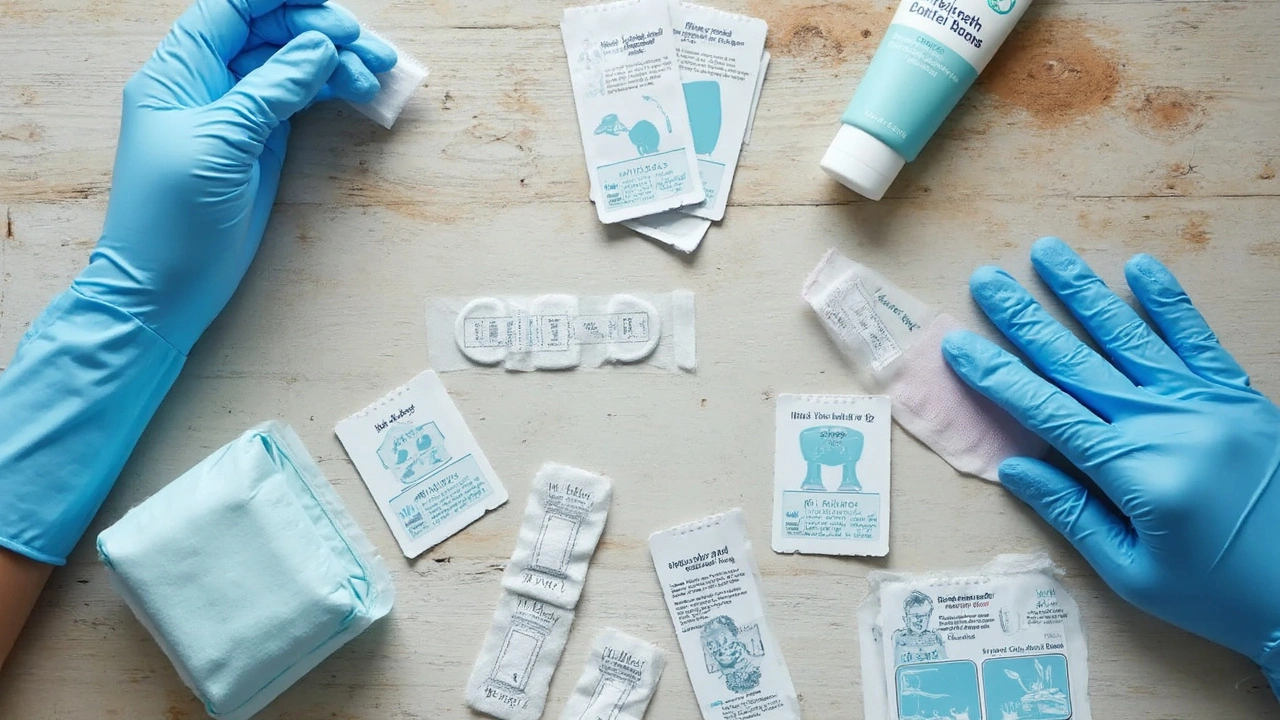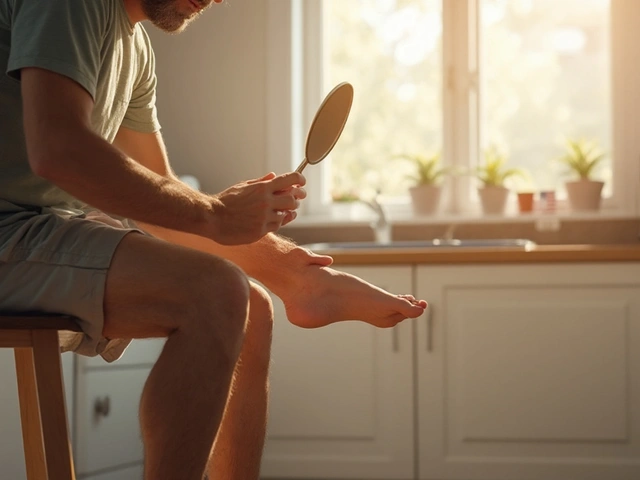Chemical burns don’t mess around. Household cleaners, car fluids, even garden products can all cause these nasty injuries before you realize what happened. With kids like Everett and Orlando running around the house—and even Apollo the bearded dragon always up to something—I learned the hard way that chemical burns can sneak up on anyone.
If you ever catch a burn starting (redness, pain, weird blisters, or even numb skin), the first thing is to get that chemical off, fast. Rinse with water—lots and lots of water—for at least 20 minutes. Hot tip: Don’t waste time looking up what the chemical is before rinsing. Just get moving and get that stuff off.
Skip ointments or creams right away; some can trap the chemical in. After flushing, check if the skin is broken, or if blisters have popped up. This is where those sores come in—open wounds that want to get infected or just never heal right if you don’t act smart.
- Spotting Chemical Burns and Their Sores
- First-Aid Steps You Should Take Immediately
- Deeper Treatments for Pain and Healing
- Keeping Infection Out—And What to Watch For
- Pro Tips to Avoid Chemical Burns Next Time
Spotting Chemical Burns and Their Sores
Not all chemical burns look the same, but there are a few signs that always pop up. The skin might turn red or white, start bubbling up in blisters, or look like it’s been bleached. Sometimes, the area might just feel numb from damage left by the chemical. If you’ve ever had bleach spill on your hand, you know it tingles and burns—multiply that feeling for strong cleaners or acids. Even small drops can make a big mess of your skin fast.
Chemical burns are different from your standard kitchen burn. They don’t always hurt right away—sometimes it takes a couple minutes before the pain kicks in. If you see swelling, dark patches, or the skin starts to break apart, you’re looking at a sore from a chemical burn. Watch for blisters or fluid-filled bubbles. Once the blister pops or wears down, you end up with a raw, exposed area—that’s your sore, and it needs real attention.
Kids and pets, like my Apollo, love to sniff and touch everything. It’s scary how quickly they can run into stuff that can burn their skin. If you notice your kid’s skin changing color or getting splotchy after messing with cleaning stuff, assume it could be a chemical burn until you know for sure.
Sometimes, burns aren’t just gross to look at—they can be dangerous. Here’s a quick look at the different grades of chemical burns:
| Burn Type | Skin Reaction | Healing Time |
|---|---|---|
| Superficial (First degree) | Red, dry, no blisters | Few days |
| Partial Thickness (Second degree) | Red, swollen, blisters, wet | 1-3 weeks |
| Full Thickness (Third degree) | White/charred, numb, leathery | Needs medical help |
Any time a chemical burn covers a big area, or the face, hands, feet, or private zones, don’t wait—get to the ER. Bleach, acids, and even mysterious household products can cause deep tissue damage that’s hard to spot at first.
If the sore oozes pus, gets redder, or smells funky, chances are infection is creeping in. Quick action makes a difference, so spotting these early signs helps save your skin—literally.
First-Aid Steps You Should Take Immediately
When a chemical burn happens, you really don’t have a second to waste. Quick action makes a huge difference in how serious those burns and sores get, and it can save you a tough recovery down the road.
- Get That Chemical Off, Now! Take off any contaminated clothing or jewelry near the burn. Use clean gloves if you can, just in case the chemical can hurt your hands too.
- Flush With Water — and Keep Flushing Rinse the burned area with cool running water right away. Twenty minutes is the sweet spot, but shoot for longer if the skin still stings or feels weird. Only skip water if you know the chemical reacts badly to it (super rare, like dry lime or some metals). For almost all household products, rinse, rinse, rinse.
- Don’t Break Blisters or Scrub Leave the blisters alone, and don’t rub the burn. Scrubbing or popping just opens the skin to infection and makes things worse.
- Protect the Area After rinsing, lightly cover the burn with a loose, non-stick bandage or clean cloth. Skip the fluffy towels—those can shed fibers and stick right to the wound.
- Watch for Breathing or Swallowing Trouble If you (or your kids or pets) breathed in the chemical, or if the burn is on the face, eyes, or a big chunk of skin, get emergency help fast. In a lot of cases, a trip to a doctor or even the ER is the smart move.
Super practical side note: The American Burn Association says nearly 10% of burn injuries come from chemicals—so you won’t be the only one dealing with this. Want a simple reference?
| Product | Flush With Water? | Extra Caution |
|---|---|---|
| Bleach, Detergents | Yes, 20+ min | Watch for breathing issues |
| Car Battery Acid | Yes, 20+ min | Remove jewelry fast |
| Dry lime, Phenol | No until dry lime brushed away | Use dry cloth first |
No matter what, after first aid, keep an eye out for signs that things are getting worse. Bad pain, oozing, huge blisters, or weird colors? That’s your cue to call your doctor right away.

Deeper Treatments for Pain and Healing
Once you’ve rinsed away the chemical, your next goal is to tackle pain and help the chemical burns and sores heal up right. Pain from these burns isn’t just annoying—it makes sleep and normal stuff tough. Good news: there are simple ways to ease the pain and speed up healing without fancy gear.
First, keep the area clean. Use a mild soap and cool water to gently wash the sore daily. Pat it dry. Don’t scrub—your skin’s in bad shape and rough treatment just slows things down. Over-the-counter painkillers like ibuprofen can make a big difference, both for pain and swelling. Tylenol works too, but ibuprofen helps even more with the ache after a burn first aid session.
Once the sore is clean, loosely cover it with a sterile, non-stick bandage. Gauze pads are perfect. Change the dressing daily, or anytime it gets wet or dirty. No need to suffocate it under heavy wraps—let your skin breathe a bit, but keep it shielded from stray bacteria. If you see a lot of clear fluid, that’s normal. But if stuff turns yellow, thick, or smells weird, infection could be starting up (we’ll dig into that soon).
Hydration really matters for skin healing—inside and out. Drink more water than usual, and skip the soda. Moisturizing the healthy skin around the sore with plain, fragrance-free lotion can help, but don’t put lotion or hydrocortisone directly on an open chemical sore unless a doctor tells you it’s safe.
Some folks wonder about burn creams or antibiotic ointments, but here’s the deal: for wound care after a chemical burn, Neosporin or similar antibiotic ointments work best only after you’ve made sure all chemical is gone. If the sore is deep or big, don’t guess—get a healthcare pro involved.
Here’s a quick breakdown of good home care steps:
- Wash hands before touching the sore area.
- Use non-stick bandages and change them every day.
- Avoid popping blisters—let them heal on their own.
- Take pain meds as labeled (no doubling up on doses).
- Keep the sore out of direct sunlight (burned skin fries even faster).
If you’re dealing with a big burn or the sore looks black, brown, or doughy, skip the home care and call your doctor now. Around 10% of chemical burns need deeper medical treatment, sometimes even hospital care. Bottom line: gentle care, clean bandages, and honest pain relief are your best bet until you can get a professional opinion if things look bad.
Keeping Infection Out—And What to Watch For
Infections are the real problem when it comes to chemical burns and their sores. Since the skin is already damaged, germs have easy access. One study found that nearly half of serious chemical burn cases end up getting infected if not cared for fast enough. That’s why you can’t just leave these wounds alone and hope for the best.
First, keep the sore clean. Wash your hands before touching it—no exceptions. Clean the area at least once a day using gentle soap and cool water. Forget about using hydrogen peroxide or alcohol; these can slow healing and make things worse.
After cleaning, cover the sore with a sterile, non-stick bandage. Change the dressing daily, or right away if it gets wet or dirty. While you might want to let the burn "breathe," that's risky when infection is a concern. A clean barrier is your friend.
- Watch for swelling or redness spreading out from the sore.
- Notice if there’s yellow or green gunk (pus), not just clear fluid.
- Check for warmth, pain getting worse, or a funky smell.
- Keep an eye on your temperature—if you start feeling feverish, things might be turning bad fast.
See a doctor if you spot any of these signs or if the sore isn’t looking better after a couple days. Better safe than sorry—antibiotics might be needed.
Here’s a quick look at symptoms that mean you need help ASAP:
| Red Flag | What it Means |
|---|---|
| Fever over 101°F | Body fighting a serious infection |
| Red streaks spreading from sore | Infection might be getting into the bloodstream |
| Blisters or blackened skin | Tissue damage is getting worse |
| Intense pain or swelling | Possible deeper issue—needs medical check |
The quicker you act on wound care and watch for infection signs, the better your odds for smooth skin and less downtime.

Pro Tips to Avoid Chemical Burns Next Time
You’d be surprised how common chemical burns are at home. According to the U.S. Poison Control, household cleaners cause over 80,000 burn injuries every year—that’s a lot of folks dealing with unnecessary pain. Most accidents can be dodged with just a bit of planning and a splash of common sense.
- Read the labels—always. If you’re grabbing a bottle of cleaner or pool chemical, skim the hazard warnings and follow the directions. It sounds simple, but most burns come from skipping these steps.
- Wear protective gear. Even when I’m cleaning out Apollo’s tank or unclogging the drain, I throw on gloves and sometimes goggles. Gloves aren’t just for show—they block most splashes and stains.
- Lock up dangerous stuff. Cleaners, bleach, acids, anything that looks like it belongs in a science lab—keep them high and locked, especially if you have kids or curious pets roaming around.
- Mix with caution. Never mix products unless the label says it’s okay. Bleach and ammonia make toxic fumes that can burn your lungs and skin. People end up in the ER just from cleaning the bathroom wrong.
- Know your first-aid plan. Tape a simple reminder inside your cleaning cabinet: Rinse with water first and call for help if it hits your eyes or skin. It’s easy to freeze up in a panic—having steps right in front of you helps.
If you work with strong stuff at your job, ask if your boss provides spill kits or extra protective gear. And for parents—kids like Everett and Orlando will reach anything eventually, so take a second look at what they can get into. That goes for pet owners, too. Apollo may not open cabinets, but not every animal is so chill.
Accidents can always happen, but with these practical steps, you cut your odds way down and avoid the hassle (and pain) of treating a sore from chemical burns later on.



okay so i just spent 20 minutes rinsing my hand after spilling drain cleaner on it bc i read this and honestly?? it saved me from a trip to the er. i thought i was being dramatic but nope-skin was turning white and numb. also my cat tried to lick my hand bc she thought i was a snack. she’s fine now. but if you have pets?? lock up the bleach. like, really lock it up. my dog once ate a whole bottle of dishwasher pods. he’s alive. i’m not. anyway thanks for the tips. i’ll be keeping this page bookmarked forever. also why does everyone think ‘cool water’ means ‘slightly warm’?? it’s gotta be cold. like, ice-water cold. i’m not joking. i put my hand under the faucet for 30 mins. my neighbor called the cops. worth it.
You rinsed for 20 minutes? Wow. What a hero. Meanwhile, I just wiped it with a paper towel and called it a day. Guess I’ll live.
OMG I’m so glad you shared this!! 🙌 I’ve been terrified of cleaning my reptile tank since my bearded dragon got a tiny burn from a vinegar spray (yes, I thought it was ‘natural’ 😅) and now I always wear gloves AND keep a bottle of water by the sink. Also-your kid’s name is Everett?? That’s my nephew’s name!! Small world!! 💕 Keep being awesome, and pls keep posting stuff like this. The world needs more ‘rinsing for 20 mins’ people. 🌱💧
Water is just a solvent. The real issue is the ego that refuses to admit you messed up.
i always forget to wash my hands before touching a burn… like, i’m just so focused on the pain that i don’t think about germs? weird right? but i’ve started keeping hand sanitizer next to my cleaning supplies now. also i think i might have a phobia of blisters. i just stare at them like they’re aliens. maybe i need therapy. or maybe i just need more info. thanks for writing this.
From a clinical dermatology standpoint, the 20-minute rinse protocol aligns with ABA guidelines for non-ionizing chemical dermal exposure, particularly with alkaline and acidic agents. The key is establishing a neutral pH endpoint via continuous irrigation, which minimizes residual tissue penetration. Topical agents like silver sulfadiazine are contraindicated in early-phase chemical burns due to potential chelation interference. Non-adherent silicone dressings are optimal for partial-thickness lesions, and systemic NSAIDs remain first-line for inflammatory modulation. Also-please stop using hydrogen peroxide. It’s not a ‘cleaner.’ It’s a cytotoxic agent that delays re-epithelialization. Just sayin’.
This article is a corporate shill for the medical-industrial complex. You’re being conditioned to panic at every spill. Did you know that the American Burn Association receives funding from pharmaceutical companies? The real solution is to stop using chemicals entirely. Switch to vinegar, baking soda, and sunlight. The government doesn’t want you to know this. Also, your cat is probably a CIA asset. They’ve been experimenting with pet behavior modification since the 1970s. I’ve seen the documents. The bleach? It’s a distraction. The real threat is the embedded microchip in your cleaning bottles. Check the barcode. I dare you.
you washed your hand for 20 mins?? what a loser. just use bleach to clean bleach. duh. also your kids are monsters. lock them up too.